
March 9, 2022, by Rupert Knight
Under the Microscope: a closer look at Ofsted’s science research review
Over the last year, Ofsted has published research reviews into a range of different subjects, designed to collate the most current and most helpful research. In the first of our University of Nottingham Primary Education Network meetings for 2022, our colleague Jo Hancock led a session with a group of school leaders and tutors from the Primary PGCE course on the science review and its implications for practice. In this blog arising from the event, Rachel Peckover summarises some of the discussions, focusing on three key aspects:
• Curriculum
• Types of scientific knowledge
• Practical work.
Introduction to the Review
Ofsted situate the review as support for those leading the subject. However, as we discussed during the network meeting, anyone teaching science is going to be leading it in one way or another and therefore it’s very relevant to a wider audience.
The review identifies the principles that will shape what Ofsted inspectors will be looking for in schools. However, it is not intended as an inspection framework or a checklist of what should be seen.
What it does do is identify what the research tells us are the key features associated with high-quality science education, recognising that there is not just one way of achieving this ‘high-quality’ and identifying a number of principles that guide how inspectors look at what they see.
Curriculum
The National Curriculum for science is very clear, comprehensive and extremely ambitious.
The research review highlights the importance of remembering its key aims to ensure that all pupils:
• develop scientific knowledge and conceptual understanding through the specific disciplines of biology, chemistry and physics
• develop understanding of the nature, processes and methods of science through different types of science enquiries that help them to answer scientific questions about the world around them
• are equipped with the scientific knowledge required to understand the uses and implications of science, today and for the future.
There is a recognition of the complexity of teaching science – the connectedness and sequencing of the curriculum is an area of particular importance.
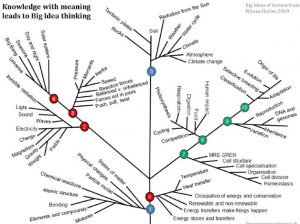
(Harlen, 2010)
This links to the inspection handbook paragraph 222: by making progression clear, pupils will know more and remember more, leading to them becoming informed citizens. Relevant examples we discussed included enabling them to have the capacity to make an informed decision on vaccination programs. The purpose of the curriculum is really worth considering alongside this research review.
One of the concerns that many of us had when carrying out monitoring of progression documents in our own schools, was that there was a lot of repetition in coverage. Different year groups were covering exactly the same work, often because year groups were rushing ahead. As recommended in the review document, and from our own discussions, we felt that carefully sequenced, small ‘chunks’ of content were needed (breaking down complex concepts and procedures), to be revisited and built up over time to support working memory, much in the same way that many of us organised our maths curriculums.
Intent, implementation and impact
One of the key messages of the review is the importance of considering curriculum intent before beginning any planning.
The review discusses research that identifies that many science curriculums are based on an ‘arbitrary collection of topics’ presented in an ‘ad hoc fashion’ and that this type of curriculum often relies on ‘interesting things for pupils to do without the rigorous scientific content’.
In post-input discussion, we discussed this further. Some schools were carrying out monitoring activities focusing on one science topic so that they could really interrogate how this was developed over time. They also carefully considered the number of lessons needed for each unit to ensure that the planning was led by the science and not the number of weeks in a half term.
The review makes it clear that planning a science curriculum should always start with the intent, however tempting it might be to get distracted by those nice ideas, sessions and experiments, which, while they might lead pupils on a pedagogical adventure, if not underpinned by curriculum intent, will fail to address coherent understanding and pupils won’t be learning.
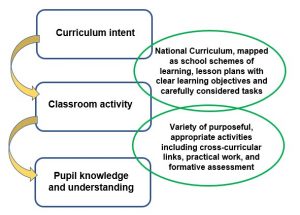
This thread of ensuring a clear intent runs throughout the whole research review.
However, the review does acknowledge that the planning and sequencing of this curriculum intent can be tricky.
Jo introduced us to useful resources such as:
• PLAN primary science assessment resources – useful tools to help ensure that progression is carefully sequenced over time, enabling our pupils to make connections and apply their scientific understanding
• The Royal Society of Chemistry ‘Steps into Science’ – a range of useful resources to show how science can be incorporated into a thematic curriculum.
The research by Danili and Reid (2004) cited in the report, makes it clear that, rather than changing the topics taught, schools should consider changes to the ordering of content as this is far more likely to lead to significant improvements. We need to be confident in the content of our curriculum and our intent and use it to develop tighter medium-term plans, moving children beyond simply remembering, allowing them to make connections between different topics and subjects whilst making the whole curriculum more manageable.
Types of scientific knowledge
The research review identifies four types of intersecting knowledge pertinent to the science curriculum:
• substantive
• disciplinary
• conceptual
• procedural
The review found that in high-quality science curriculums, content is carefully sequenced to reveal the interplay between both substantive (essentially, the content aspects of the curriculum) and disciplinary (working scientifically aspects) knowledge. Whilst classroom teachers are not expected to use these terms, they are useful in the planning stage and when considering what different types of scientific knowledge might look like.
Disciplinary knowledge has been broken down further:
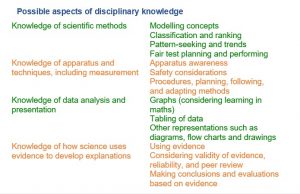
When asked, whether this ‘disciplinary knowledge’ isn’t just the same as skills, Ofsted explained that this type of knowledge can be viewed in more discrete units (see above) which then come together to make up scientific skills.
To illustrate this interplay, Jo gave the example of a lesson on parachutes: seeing which parachutes are going to fall the fastest or the slowest, the children are likely to be using their disciplinary knowledge at whatever level they are at to plan a fair test, conclude and evaluate, but they will also need some substantive knowledge of air resistance, and about gravity and weight, even if not completely familiar with using these words or concepts.
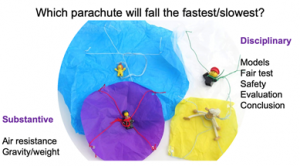
This key message is not new, but the research review aims to make it clearer – disciplinary knowledge has to be built upon a good grounding of substantive knowledge.
The review then asks us to consider a second layer of knowledge: conceptual (things that pupils need to understand) and procedural (things that pupils need to be able to do). The Primary Science Education Consultancy has a blog unpicking the vocabulary of the science review and they provide a table, which can be viewed in full here., aligning conceptual and procedural knowledge with substantive and disciplinary knowledge
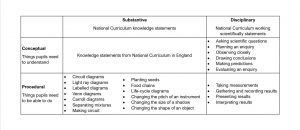
Practical science
Jo cautioned against the teaching in isolation of both conceptual-substantive knowledge (children just knowing statements) and procedural-disciplinary knowledge (children conducting experiments but not knowing why they’re doing them). One way of addressing this is to conduct regular scientific enquiry to enable pupils to cover all types of knowledge.
We know that practical science is important; it underpins the core of what the subject is. We wouldn’t expect a child to understand how to play football if they couldn’t physically practise those skills. However, there needs to be a solid rationale for it. We need to ensure that:
• the children have the prior knowledge required
• it is related to the curriculum intent
• it forms part of a wider sequence
In post-input discussion, we agreed that our pupils found it difficult to clearly articulate why they study this subject and why it is useful, outside of the science lesson and that disciplinary knowledge was often lacking.
To combat this, one school in the group had developed ‘working scientifically statements’ so that pupils were explicitly aware of different aspects of this each time they were actually engaging with it.
Linking back to the purpose of the research reviews, which may be used to guide what inspectors are thinking when they visit a school, if teaching a practical science lesson during an Ofsted visit, be prepared to be asked: what is the intent of the lesson; how does it connect to the wider curriculum; can the children explain why they are carrying out the practical work?
At every stage of science planning and teaching, the intent needs to be crystal clear!
Some questions to ponder
• Does your curriculum clearly identify what pupils need to know?
• How is it sequenced to ensure progression and a developing disciplinary understanding?
• Does it meet the needs of all pupils?
• Do teaching materials support the intent?
• Do pupils have opportunities to carry out scientific enquiry? Are there any challenges to this?
Further useful resources
• Derbyshire and Nottinghamshire Science Learning Partnerships
• IoP Spark
• The science teacher
Reference
Harlen, W. ed., 2010. Principles and big ideas of science education. Association for Science Education.
No comments yet, fill out a comment to be the first

Leave a Reply